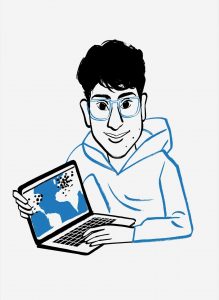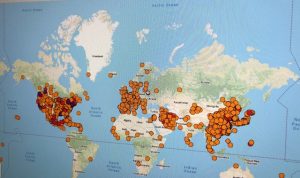17-year-old Codes Pandemic
Local Journalism
March 30, 2020‘Like many in business, trusted news organizations are being hit hard by this pandemic. If you can, please consider subscribing to your local paper or contributing to a VT news organization. You deserve transparency and the truth, and they work hard to keep you informed.
-Vermont Governor Phil Scott
NYTimes
Ben Smith
“Abandon most for-profit local newspapers, whose business model no longer works, and move as fast as possible to a national network of nimble new online newsrooms. That way, we can rescue the only thing worth saving… the journalists.”
Bail Out Journalists. Let Newspaper Chains Die.
The coronavirus is likely to hasten the end of advertising-driven media, our columnist writes. And government should not rescue it.
“There’s all this ‘doom and gloom for local journalism stories’ that have happened in the last week or so, and I hope that other people see what we’re doing and understand that the important thing is the journalism — it’s the stories, it’s the investigations — that’s what matters,” Ken Ward said. He will also be on the staff of the nonprofit investigative powerhouse ProPublica and will have support from Report for America, another growing nonprofit organization that sends young reporters to newsrooms around the country.
The news business, like every business, is looking for all the help it can get in this crisis. Analysts believe that the new federal aid package will help for a time and that the industry has a strong case to make. State governments have deemed journalism an essential service to spread public health information. Reporters employed by everyone from the worthiest nonprofit group to the most cynical hedge fund-owned chain are risking their lives to get their readers solid facts on the pandemic, and are holding the government accountable for its failures. Virtually every news outlet reports that readership is at an all-time high. We all need to know, urgently, about where and how the coronavirus is affecting our cities and towns and neighborhoods.
So what comes next? That decision will be made in the next few months — by public officials, philanthropists, and other tech companies, and people like you.
The right decision is to consistently look to the future, which comes in a few forms. The most promising right now is Ms. Green’s dream of a big new network of nonprofit news organizations across the country on the model o The Texas Tribune, which Mr. Thornton co-founded. There are also a handful of local for-profit news outlets, like The Seattle Times, The Los Angeles Times and The Boston Globe, with rich and civic-minded owners, and The Philadelphia Inquirer, which is owned by the non-profit Lenfest Institute for Journalism. And there is a generation of small, independent membership or subscription sites and newsletters like Berkeleyside.
Elizabeth Green, a founder of Chalkbeat, a nonprofit news organization reporting on education issues, in Washington, D.C.
[Avi Schiffmann]
The High Schooler Who Became a COVID-19 Watchdog
The New Yorker
by Brent Crane
In December, DT said, “We have a problem that, a month ago, nobody thought about.” Well, somebody did. On December 29th, as DT vacationed with his family at Mar-a-Lago, Avi Schiffmann, a seventeen-year-old from Washington State, launched a homemade Web site to track the movement of the coronavirus. Since then, the site, ncov2019.live, has had more than a hundred million visitors. “I wanted to just make the data easily accessible, but I never thought it would end up being this big,” the high-school junior said last week over FaceTime. Schiffmann, gap-toothed and bespectacled, was sitting on his bed wearing a blue T-shirt and baggy pajama bottoms. It was late morning. He was at his mother’s house, on Mercer Island, outside Seattle.
Using a coding tactic known as “web-scraping,” Schiffmann’s site collates data from different sources around the globe—the W.H.O., the C.D.C., Yonhap News Agency in South Korea—and displays the latest number of covid-19 cases. It features simple graphics and easy-to-read tables divided by nation, continent, and state. Data automatically updates every minute. In a politicized pandemic, where rumor and panic run amok, the site has become a reputable, if unlikely, watchdog.
He began teaching himself to code when he was seven, mainly by watching YouTube videos, and has made more than thirty Web sites. “Programming is a great creative medium,” he said. “Instead of using a paintbrush or something, you can just type a bunch of funky words and make a coronavirus site.” One of his first projects, in elementary school, was what he calls “a stick-figure animation hub.” Later sites collated the scores for his county’s high-school sports games, aggregated news of global protests, and displayed the weather forecast on Mars. “His brain is constantly going from one thing to another, which is good, but I also try to focus him in,” his mother, Nathalie Acher, said. “I’m not techy at all myself. I see it as just really boring. He sees it as an art form.”
Schiffmann took the virus threat seriously before many others did. “I’ve been kind of concerned for a while, because I watched it spread very fast, and around the entire world. I mean, it just kind of went everywhere.” He took his own precautions. “I got masks a while ago. I got, like, fifteen for seventeen dollars. Now you can’t even buy a single mask for, like, less than forty.” His mother chimed in. “I wish I had listened to him,” she said. “But, in his teen-ager way, he’d come down the stairs with his eyes huge and be, like, ‘There are fifty thousand more cases!’ and I’d be, like, ‘Yeah, but they’re over there, not here.’ ”
Her son is a C student.
Now that the grownups of the world are finally, and appropriately, freaking out, it is hard for Schiffmann not to feel righteous vindication. “If you told someone three months ago that we should spend, like, ten billion dollars in upgrading the United States’ health care, they would have been, like, ‘Nah,’ ” he said. “Now, everyone’s, like, ‘Oh, my God, yes.’ But this is the kind of stuff we should have done a long time ago.”
Young people give me so much hope. ❥ -dayle


